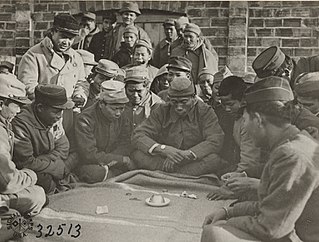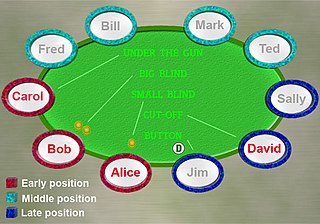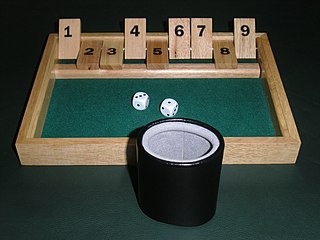Related Research Articles

Craps is a dice game in which players bet on the outcomes of the roll of a pair of dice. Players can wager money against each other or against a bank. Because it requires little equipment, "street craps" can be played in informal settings. While shooting craps, players may use slang terminology to place bets and actions.

Chuck-a-luck, also known as birdcage, or sweat rag, is a game of chance played with three dice. It is derived from grand hazard and both can be considered a variant of sic bo, which is a popular casino game, although chuck-a-luck is more of a carnival game than a true casino game. The game is sometimes used as a fundraiser for charity.

In the game of poker, the play largely centers on the act of betting, and as such, a protocol has been developed to speed up play, lessen confusion, and increase security while playing. Different games are played using different types of bets, and small variations in etiquette exist between cardrooms, but for the most part the following rules and protocol are observed by the majority of poker players.

Texas hold 'em is the most popular variant of the card game of poker. Two cards, known as hole cards, are dealt face down to each player, and then five community cards are dealt face up in three stages. The stages consist of a series of three cards, later an additional single card, and a final card. Each player seeks the best five-card poker hand from any combination of the seven cards: the five community cards and their two hole cards. Players have betting options to check, call, raise, or fold. Rounds of betting take place before the flop is dealt and after each subsequent deal. The player who has the best hand and has not folded by the end of all betting rounds wins all of the money bet for the hand, known as the pot. In certain situations, a "split pot" or "tie" can occur when two players have hands of equivalent value. This is also called "chop the pot". Texas hold 'em is also the H game featured in HORSE and HOSE.

Hazard is an early English game played with two dice; it was mentioned in Geoffrey Chaucer's Canterbury Tales in the 14th century.

Shut the box is a game of dice for one or more players, commonly played in a group of two to four for stakes. Traditionally, a counting box is used with tiles numbered 1 to 9 where each can be covered with a hinged or sliding mechanism, though the game can be played with only a pair of dice, pen, and paper. Variations exist where the box has 10 or 12 tiles.

Mia is a simple dice game with a strong emphasis on bluffing and detecting bluff related to Liar's dice.
Liar's dice is a class of dice games for two or more players requiring the ability to deceive and to detect an opponent's deception. In "single hand" liar's dice games, each player is given a set of dice, all players roll once, and the bids relate to the dice each player can see plus all the concealed dice. In "common hand" games, there is one set of dice which is passed from player to player. The bids relate to the dice as they are in front of the bidder after selected dice have been re-rolled. Originating during the 15th century, the game subsequently spread to Latin American and European countries. In 1993, a variant, Call My Bluff, won the Spiel des Jahres.

Cee-lo is a gambling game played with three six-sided dice. The name is derived from the Chinese name for the game, which is literally the numerical sequence four-five-six. Although many variations exist, there are certain common rules, including the use of three dice and common roll combinations, such as rolling a 4-5-6 to win, 1-2-3 to lose, and other combinations which establish a point for comparison to rolls by other player(s).

Sic bo, also known as tai sai (大細), dai siu, big and small or hi-lo, is an unequal game of chance of ancient Chinese origin played with three dice. Grand hazard and chuck-a-luck are variants, both of English origin. The literal meaning of sic bo is "precious dice", while dai siu and dai sai mean "big [or] small".
Mexico is an elimination-style dice game, in which several players agree to play a set number of rounds. After each round, the losing player pays into a common pot of money. When all players but one have been eliminated by losing all their money, the remaining player wins the game and the pot. Owing to its extremely simple play-structure, it is generally pursued as a method of gambling, whereby the final remaining player wins the amount of money wagered by each person who was eliminated in earlier rounds. Scoring is identical to the dice game Mia, but Mia has very different game mechanics, as it is a variant of the drinking game liar's dice. The game Bidou has a similar scoring system, but uses three dice instead.

Ship, Captain, and Crew is a drinking game played with five dice. The game can be played with as few as two people but is usually played in a group of five or more. The object of the game is to roll a six, a five ("captain"), and a four ("crew") with three dice, and get the highest score with the other two dice. In other versions, a four is the "mate" and the remaining dice are the crew.
Kitsune Bakuchi (狐博奕) is a dice game from Japan in which a player rolls three dice; if the roll results in a triple, i.e., each die shows the same number, they win four times the amount wagered. The term literally means "fox gambling."
A number of related games under the Yahtzee brand have been produced. They all commonly use dice as the primary tool for game play, but all differ generally. As Yahtzee itself has been sold since 1954, the variants released over the years are more recent in comparison, with the oldest one, Triple Yahtzee, developed in 1972, eighteen years after the introduction of the parent game.
The following is a glossary of poker terms used in the card game of poker. It supplements the glossary of card game terms. Besides the terms listed here, there are thousands of common and uncommon poker slang terms. This is not intended to be a formal dictionary; precise usage details and multiple closely related senses are omitted here in favor of concise treatment of the basics.
Draw poker is any poker variant in which each player is dealt a complete hand before the first betting round, and then develops the hand for later rounds by replacing, or "drawing", cards.

Casino security refers to the measures that are taken at casinos to protect the establishment's money, property and patrons. The security protects the casino and its customers from violent crime, theft, and other inappropriate behavior.

Midnight is a dice game played with six dice.

The following is a glossary of terms used in the dice game craps. Besides the terms listed here, there are many common and uncommon craps slang terms.

Cacho Alalay is a popular dice game from Latin America. It is similar to Yahtzee/Yatzy. The purpose of the game is to roll five dice and score points from their combinations. The dice are rolled from a leather cup.
References
- 1 2 3 Simpson, George Gaylord (1934). Attending Marvels: A Patagonian Journal . The MacMillan Company.
- 1 2 3 4 5 6 7 8 9 10 11 12 13 14 15 16 17 18 19 20 21 22 23 Botermans, Jack (2008). The Book of Games: strategy, tactics & history . Translated by Fankbonner, Edgar Loy. New York: Sterling Publishing Co., Inc. p. 337. ISBN 978-1-4027-4221-7.
- ↑ Redden, Earl (November 1937). "Plot Redden Sends News From South America". The Air Line Pilot. Vol. 6, no. 11. p. 2. Retrieved 16 January 2025.
- ↑ Bruce, James (1953). Those Perplexing Argentines. Longmans, Green and Co. pp. 27, 45. LCCN 53-10840.
- ↑ Crow, Carl (September 1941). "The Checkerboard City of Lima". Travel. Vol. 55, no. 5. pp. 22–26, 38. Retrieved 16 January 2025.
- ↑ Perret, Geoffrey (2001). Jack: A Life Like No Other . Random House. ISBN 0-375-50363-3.
- 1 2 3 4 5 6 7 8 9 10 11 12 Frey, Skip (1978). Complete book of dice games . Sphere Books Ltd. pp. 55–58. ISBN 0-7221-3681-1.
- 1 2 3 4 5 6 7 8 9 10 11 12 13 14 15 16 17 18 19 20 21 22 Family Fun & Games . Sterling Publishing Co., Inc. 1992. pp. 110–113. ISBN 0-8069-8776-6.
- 1 2 3 4 Welch, Scotty; Welch, Ronnie (1965). Esquire Party Book . Illustrated and designed by Seymour Chwast. New York: Esquire, Inc. pp. 303–306. LCCN 65-15415.
